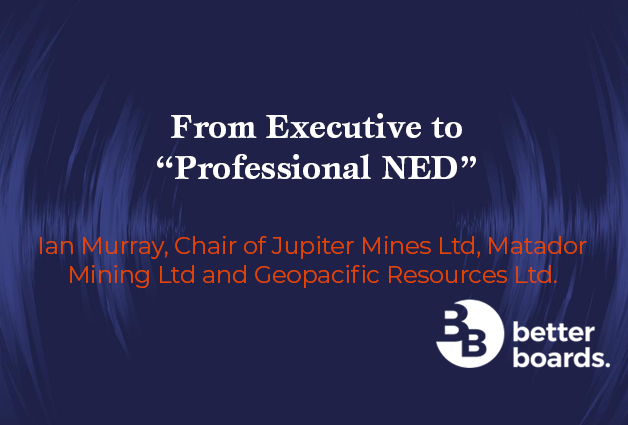From Executive to “Professional NED”

Many Executives dream of a portfolio career, even attending specially designed courses, paying to qualify and increase their chances of securing a seat at the top table.
Many Executives dream of a portfolio career, even attending specially designed courses, paying to qualify and increase their chances of securing a seat at the top table. Yet only a relatively small number manage to create a strong portfolio and become a “Professional Non-Executive Director.”
In this podcast, Dr Sabine Dembkowski (founder and manager of Better Boards) discusses Non-Executive directorship with Ian Murray, Chair of mining companies Jupiter Mines Ltd and Matador Mining Ltd, also Non-Executive Director on the board of Black Rock Mining Ltd and Geopacific Resources Limited, as well as Director of charity and not-for-profit Miners Promise Ltd and Miners Promise Australia Ltd. Previously Ian was Executive Chair and Managing Director of Gold Road Resources Ltd and DRD Gold Ltd, and held leadership positions with ‘Big Four’ accounting firms. Ian has received prestigious awards, including the Diggers and Dealers Deal of the year award, best-emerging company award, and the CEO of the year award from the CEO Magazine.
Some of the key takeaways of the conversation include:
“Different companies at different stages of development, different geography, different commodities”
Ian relates how he was first appointed as an Executive Director, from where he progressed to CEO and Managing Director, before deciding that it was time to diversify his experience across a number of companies, and move to Non-Executive roles. Since then, he has been involved in mentoring and building new executive directors for 20 years.
Ian especially advocates diversity – working with different companies at different stages of development, geographies, and commodities is something he has always found exciting and interesting. He is enthusiastic about helping build and guides people new to Non-Executive director roles and those hoping to enter such roles.
“Learn to be a jack of all trades and understand what’s required across the full spectrum”
Ian believes the critical advice for executive directors is to focus on their current job and building successful careers, becoming better known in their industry, and thus more likely to be sought after for Non-Executive roles. This focus also gives a broader base to move into Non-Executive roles. Also, he advises not being focused purely on one core skill set but learning broad skills and knowledge. This foundation in an executive director role will enable transition into a successful Non-Executive director role.
Diversity in skills is not the only factor. Ian describes diversity not just at the board level but also in terms of a portfolio of companies an executive may be involved with. He cautions against working with several companies doing the same thing, not least because of conflict of interest. He also points out that nowadays, boards are diversified, and comprised of different skill sets, so individuals bring specific skill sets onto a board and play their part as a specialist in that area.
“Keep out of the kitchen”
Ian explains that switching from executive to Non-Executive director takes discipline because, as an executive, you roll up your sleeves and get involved “hands-on in the kitchen,” as it were. As a Non-Executive, it is essential always to take a step back, remembering that the role is to provide guidance and mentor the executive team while keeping your radar operating. If things start to go off track, you can then advise the management team and step in and make changes as soon as possible before things go badly off track. This is challenging at times but is necessary because the role of a Non-Executive is to look after the shareholders, who will hold you accountable for things going off track. So, Ian cautions the need for implementing and bringing about change and correction as soon as possible, as once things have fallen off track, it is both costly and time-consuming to rectify.
“What haven’t the management team been telling you?”
Ian feels the role of a Non-Executive in board meetings is to listen and engage with the updates and presentations from the management team, then to process that information and come up with insightful and probing questions. What hasn’t the management team been telling you? What other information should the Non-Executives be aware of that hasn’t been presented? Look for the gaps in the information.
That being said, Ian advocates focusing on the macro and not the micro because focusing on the micro is “going back into the trenches” with the management team. As a Non-Executive, focus should be on the big picture and what is driving the company forward – how to add more value for shareholders. Ian describes that as a Non-Executive, you need to move up to a more strategic level and have the management team work across all operational issues.
Ian also warns about appearing too critical in asking questions, always remembering the management team have put a lot of effort into their presentations and board packs. Helpful questions, not critical questions, are best, as is being attentive in meetings – focus, concentrate and give the executive team 100% attention. Finally, he advises against placing focus only on the CEO. Normally, the CEO will have different members of the management team presenting their sections, and it is important to remember to engage with them. They are learning to present to the board as part of their own development, because some may have aspirations to move up to CEO.
“You have to take it seriously; you have to put in the investment”
Ian notes extensive work is required between board meetings, reading, researching, engaging with management, asking follow-up questions and issues of clarity and undertaking any work delegated from the board. He estimates that there is three or four hours of preparation for every board meeting. He allocates approximately one day per week to a Non-Executive role, so 50 days a year – and for a Chairman role, two days a week or 100 days a year.
The three top takeaways from our conversation are:
- Being a Non-Executive is a career, not a lifestyle, and must be taken seriously between board meetings and during them.
- Time commitment is significant, and for every hour of board meeting, additional hours are required to prepare to do the job properly.
- A Non-Executive is responsible to all shareholders, and the question should always be, “What would shareholders want you to do in this situation?
Don’t forget to subscribe never to miss an episode of the Better Boards Podcast Series. Available on Apple, Spotify or Google.
To find out how you can participate in the Better Boards Podcast Series or more information on Better Boards’ solutions, please email us at info@better-boards.com.



